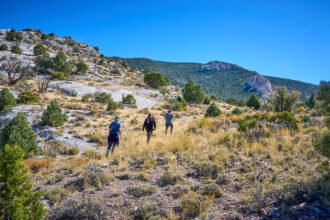Over the course of three hours on Thursday evening, the beige-paneled walls of the SpringHill Suites Hotel in Chester, Virginia played host to a sometimes-contentious meeting between Dominion Energy, the state’s largest utility provider, and residents of the Chesterfield community, where Dominion has proposed to build a new natural gas power plant.
The plant, called the “Chesterfield Energy Reliability Center” by the utility, has been billed as a “peaker,” meaning it would only run during periods of high demand or during extreme weather events. Dominion says this plant would “respond quickly with reliable, dispatchable power generation to the grid when needed,” including when renewable energy is unavailable or “insufficient to meet customer needs.”
Dominion, Virginia’s largest utility, has operated another fossil fuel power plant in Chesterfield since the mid-20th century, and estimates that the new Chesterfield plant could run, at most, for almost five months a year.
“We are deeply concerned with Dominion’s refusal to truly change course and move toward a clean and equitable energy system,” said Rachel James, a Chesterfield resident and an associate attorney with the Southern Environmental Law Center, at a press conference hosted by environmental organizations ahead of the public meeting.
“SELC opposes this project,” she said.
“Forty-four percent of the personnel who live near this proposed plant are people of color, people that look like myself,” said Nicole Martin, head of the Chesterfield chapter of the NAACP and a Chesterfield resident. “If you know better, do better. We know what these harmful toxins have done to us in the past,” she said. “Now that we know better and aren’t doing better, that is a problem.”
Victoria Higgins, the Virginia director of the Chesapeake Climate Action Network, called the project a “slap in the face” to the Chesterfield community.
Emil Avram, Dominion’s vice president of business development, said the new Chesterfield plant “will help enable a lot of renewable energy to be constructed.” He said that Dominion plans to deploy between 35 to 40 gigawatts of solar, wind and battery storage (one gigawatt is equal to 1,000 megawatts) and that “95 percent of the energy for new projects that we plan to deploy will be zero-carbon generation.”
In response to a question regarding the cumulative impact of emissions from the proposed plant on the Chesterfield community, which has had a coal-fired facility nearby for several decades, Avram said “that analysis is still ongoing” as part of Dominion’s air permit application process.
This is not the first time Dominion has sought to build a natural gas power plant in Chesterfield. In 2019, the utility proposed a similarly sized plant only to scrap the idea later that year. The company never gave an official reason for that decision.
Then, in 2020, Virginia lawmakers passed the Virginia Clean Economy Act, which annually increases the proportion of Dominion’s energy that must come from renewables, requiring 100 percent in 2045 and thereafter.
But in its recently released Integrated Resource Plan, Dominion forecasted a surge in its emissions and a spike in energy demand, startling those who expected the utility to decrease emissions and ramp up renewable energy investments.
The spike in demand, according to Dominion, will come largely from data centers, which contain infrastructure critical to maintaining worldwide internet operations. Northwest Virginia, home to numerous such centers, is sometimes referred to as “the data center capital of the world.”
Questioning the Q&A
The new Chesterfield plant is the first fossil fuel power plant Dominion has proposed in Virginia since the passage of the Virginia Clean Economy Act. Virginians used Thursday’s meeting, a step required by the state’s Department of Environmental Quality (DEQ), to press Dominion on environmental justice, its commitment to renewables and suggest other ways of meeting peak energy demands.
During the course of the Q&A, the utility and the Chesterfield community appeared far apart on almost every issue raised—even the Q&A format the company chose for the evening.
Dominion had brought several employees to the meeting, including experts on air quality, and asked those in attendance to approach them individually with questions in the back of the room. A court reporter, who was entering questions and responses into the record, was stationed at the front.
But those in attendance pushed back on Dominion’s setup, worried that by splitting up they were missing out on the chance to hear answers to other questions, be inspired by their peers and ensure that their questions and Dominion’s responses were entered into the record.
“We learn when each other asks questions and when we hear the answers all together as a community,” said one woman standing in the back of the room. “If this is a community meeting, we need to approach this as a community. Not as individuals.”
Dominion insisted this format worked best and was “most efficient.”
“They sound like they don’t want to answer our questions,” another woman said.
“It’s not about that,” responded Avram, who spent the initial minutes of the Q&A defending the utility’s chosen format.
Over scattered chatter, one person suggested an alternative method for dialogue between the company and the community. “We haven’t set it up in that format,” Avram said.
“Then change what you’re doing!” an audience member responded, an exchange that almost perfectly captured the fundamental tension between the two groups in the room.
After going back and forth for several minutes, Dominion appeared to relent, and Avram, Sarah Marshall, Dominion’s manager of state and local affairs, and other Dominion representatives shared the microphone to field questions from community members.
Lindsey Dougherty, a resident who lives near the proposed site of the plant, pressed Dominion on emissions from the plant. “My child has asthma,” she said. “As a parent of a child who is already negatively impacted, this is just going to add to it. We are going to bear 100 percent of the negative health impacts and the costs as ratepayers.”
Avram said that the emissions associated with the facility would be “well below federal and state thresholds.”
Another attendee asked how the utility could justify building a plant that needed to be retired by 2045, according to requirements set forth by the Virginia Clean Economy Act. “This facility may not retire in 2045,” Avram said.
That answer appeared to unsettle the audience. One man sitting in the front stood and asked whether Dominion planned to retire this plant in compliance with the renewable energy mandates in the Virginia Clean Economy Act.
“We don’t know the answer to that yet,” Avram said, setting off a string of responses throughout the audience.
Avram handed Marshall the microphone. “Yes, we do want to follow the Clean Economy Act. That is our plan, that is our goal,” she said, before adding that the act has provisions that would allow Dominion to add fossil fuel plants to the grid to ensure reliability.
Fossil Fuel Treadmill
Dominion has been operating in Chesterfield since the mid-20th century, when it opened a coal-fired power plant there. Parts of that infrastructure generated energy as recently as this spring before Dominion officially retired the last of its coal units at the end of May. Now, the original facility, known as the “Chesterfield Power Station,” runs on oil and gas.
Closing the coal units has not eradicated environmental harms associated with the original facility: Dominion is in the process of cleaning up about 16.2 billion pounds of coal ash from two coal ash ponds at its Chesterfield facility, part of a legal requirement passed by the general assembly in 2019 that gives the company 15 years to complete the project.
In its public hearing announcement, Dominion acknowledged that “the existing Chesterfield Power Station is classified as a major source of air pollution,” and said the new facility “will be considered a major modification to the Chesterfield Power Station permit.”
The maximum annual emissions from the new plant would be 2.2 million tons of CO2, according to Dominion.
Bill Shobe, a professor of public policy at the University of Virginia who did not attend the public meeting, agreed with Dominion’s assessment of a surge in power demand on a phone call with Inside Climate News. But he called the company’s plan to build a natural gas plant “worrisome.”
“We should be developing a plan that gets us to 2050 and provides us with reliable electricity and allows us to continue to have data center growth without increasing our damaging CO2 emissions,” said Shobe, who studies and designs policies governing emissions from the power sector.
In its Integrated Resource Plan, Dominion outlined a path that would raise its emissions to 36 million metric tons of CO2 in 2048, more than twice what the utility emitted in Virginia last year, according to the Environmental Protection Agency, and well above the threshold outlined by the Virginia Clean Economy Act.
“When is Dominion going to take seriously the obligation to get us off the fossil fuel treadmill?” Shobe said.
A day after Dominion’s public information session, Gabel Associates, an environmental consulting firm, released a report commissioned by the Chesapeake Climate Action Network that presented another way forward for the utility. The report, which drew on publicly available data, found that Dominion could still reliably meet its forecasted demand by accelerating the retirement of fossil fuel plants, adding more battery storage and increasing energy efficiency investments, among other steps. This would drastically reduce the utility’s emissions, save ratepayers money and still reliably deliver energy, the report concluded.
“This report shows it is not only possible for Dominion to fulfill projected demand with clean energy, as per the guidelines of state law, but it is also in everyone’s best interest,” said Adrian Kimbrough, vice president of Gabel Associates, in a statement.
Higgins said the organization commissioned the report shortly after Dominion released its Integrated Resource Plan, which Higgins found alarming. Higgins remembers Gov. Glenn Youngkin released a statement on Dominion’s plan later that same day, praising Dominion for pursuing an “all of the above” energy strategy going forward.
“The fact that this aligns completely with the Youngkin energy plan is a major, if not leading reason why Dominion feels emboldened to move forward with this project,” Higgins said, referring to the Chesterfield power plant. “There are two people that do benefit from this plan,” she continued. “One is Gov. Youngkin, who’s campaigned on repealing our climate policies and taking us backwards. And the other is Dominion shareholders that get excited about a really expensive project to get a guaranteed return.”
A spokesperson for Gov. Youngkin did not return a request for comment.
If Dominion took the steps outlined in the new report, it “gets us to where we’re avoiding 52 million tons of greenhouse gas emissions and saving rate payers $28 billion over the next ten years in costs,” Higgins said.
Dominion must secure local permits and open the project for a public comment period sometime in the second half of 2024 before construction on the proposed Chesterfield plant could begin. Virginia’s DEQ is currently reviewing Dominion’s application for an air permit, a process the agency says normally takes a year.











